|
|
|
|
|
|
|
Achi-Kochi Japan
Showing many places to visit and foods to eat in Japan
|
|
|
|
|
|
|
|
|
|
|
|
|
Japan
> Kinki region
> Kumano Sanzan and Kumano Kodo, Wakayama Prefecture
|
|
|
|
|
|
|
Kumano Sanzan and
Kumano Kodo
Wakayama Prefecture, Kinki ( Achi-Kochi Japan )
|
|
|
|
|
|
|
|
|
|
|
|
|
( "Achi-Kochi" in Japanese means "Here and there" in English. )
Kumano Sanzan and Kumano Kodo

In A.D.907, Retired Emperor Uda walked a few hundred kilometers from Kyoto to Kumano Sanzan area ( above ) where three Kumano Taisha ( Kumano Grand Shrines ) are located. Since then on, dozens of Retired Emperors and members of the Imperial House had walked along Kumano Kodo ( Kumano ancient paths ) to visit Kumano Sanzan.
UNESCO World Heritae Site "The Sacred Sites and Pilgrimage Routes in Kii Mountain Range" consists of Kumano Sanzan ( three Kumano Taisha and Seiganto-ji Temple ), Kumano Kodo and some more. So many tourists visit the area.
|
|
Kumano Kodo
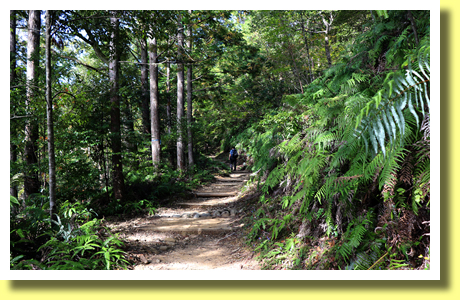
For over 1,000 years, many people, not only members of Imperial House but also noblemen, samurai warriors, farmers, craftsmen and merchants walked along Kumano Kodo ( Kumano ancient paths - above ).
Kumano Kodo, pilgrimage routes, was a network connecting three Kumano Taisha ( three Kumano Grand Shrines ), Koya-san, Yoshino, Ise and some temples.
|
|
Stone Pavement of Kumano Kodo

There remain stone pavement ( above ) in some parts of Kumano Kodo. Kii Mountain Range, where Kumano Kodo is located, is famous for abundant rainfall. So stone pavement was needed.
Not all the people, visiting Kumano Sanzan, walk along Kumano Kodo. However tourists could enjoy walking along just some parts of Kumano Kodo, which is rich in nature.
|
|
Kumano Hongu Taisha
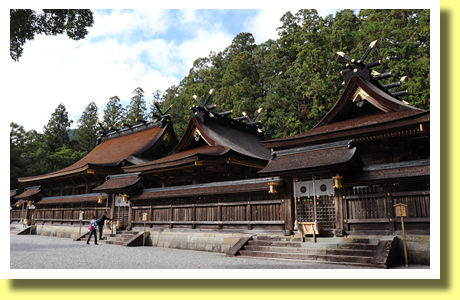
Kumano Hongu Taisha ( above ), one of Kumano Grand Shrines in Kumano Sanzan, is located in Tanabe City, Wakayama Prefecture. It is unknown when Hongu Taisha was founded though a document written in the 9th century refers Hongu Taisha.
The 1st-2nd and 4th main halls were built in A.D.1802 and the 3rd in A.D. 1810. They are designated National Important Cultural Properties of Japan. Hongu Taisha is the head shrine of more than 3,000 Kumano shrines founded Achi-Kochi ( here and there ) in Japan.
|
|
Oyu-no-hara
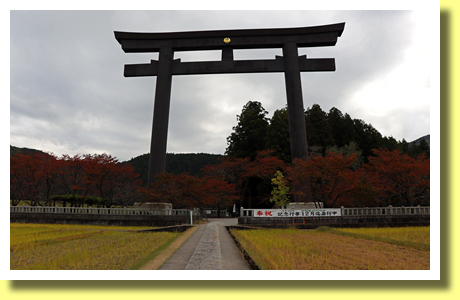
Hongu Taisha used to be located in the site called "Oyu-no-hara" where the buildings of Hongu Taisha were partially destroyed in a flood in A.D.1889. So they were moved one kilometer and reconstructed in its present site in A.D.1891. In Oyu-no-hara Otorii ( large torii gate 33.9 meters tall - above ) was erected in A.D.2000.
|
|
Tsubo-yu

There are a few onsen ( hot springs ) near Hongu Taisha. One of them is Yunomine Onsen where Tsubo-yu bath ( above ) is located. "Tsubo" in Japanese means "pot" while "yu" does "hot water". So "Tsubo-yu" means "hot water in a pot". The rock pot bath is barely big enough for two adults.
Tsubo-yu is included in UNESCO World Heritage Site. It is said that ancient pilgrims used hot spring water for purification as a process of the pilgrimage.
Tourists, who would like to use Tsubo-yu, are to purchase tickets and book the bath time at the Yunomine Public Bathhouse Desk. However Tsubo-yu is so popular among tourists. So tourists could use the public bathhouse instead.
|
|
Mehari-Zushi
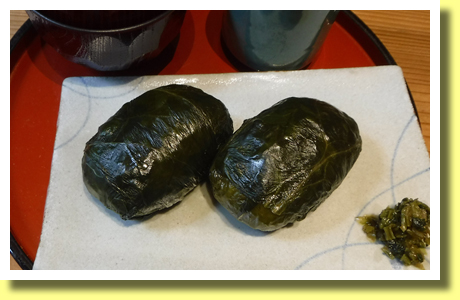
In Kumano Sanzan area, there are some restaurants which offer traditional local specialty dishes such as Mehari-Zushi ( above ), which is rice balls wrapped in pickled Takana ( leaf mustard ). Mehari-Zushi, not topped with fish, is a unique kind of sushi.
Traditionally those who worked in mountains, forests and paddy fields ate Mehari-Zushi for lunch in this area. Nowadays Mehari-Zushi lunch boxes are popular among some people who walk along Kumano Kodo.
|
|
Kumano Hayatama Taisha
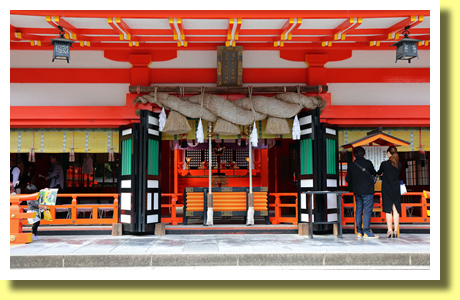
Kumano Hayatama Taisha ( above ), one of Kumano Grand Shrines in Kumano Sanzan, is located in Shingu City, Wakayama Prefecture. Though it is unknown when Hayatama Taisha was founded, some say that it was founded in the 3rd-4th century.
Hayatama Taisha hold lots of designated National Treasures of Japan and designated Important National Cultural Properties of Japan. Its treasure hall exhibits a dozen of National Treasures of Japan.
|
|
Stone Steps up to Kamikura-jinja shrine

There is Kamikura-jinja shrine near Kumano Shingu Taisha. Visitors are to climb 538 steep stone steps ( above ) up to Kamikura-jinja. According to a document, the stone steps were dedicated in A.D.1193 by Yoritomo Minamoto who had established Kamakura Shogunate in Kamakura ( ==> A History of Japan vol.2 Samurai Age ).
|
|
Kamikura-jinja shrine and Gotobiki-iwa rock
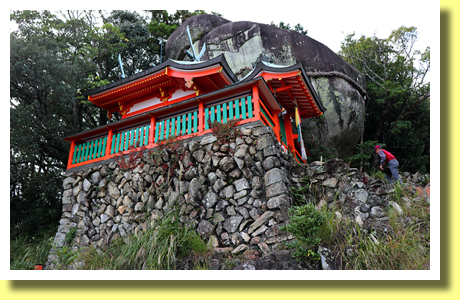
It is said that Kamikura-jinja shrine ( above ) was founded in the 2nd century to enshrine Gotobiki-iwa rock ( above ). Some say that the Gods, enshrined in Kumano Sanzan, descended onto Gotobiki-iwa rock. Kamikura-jinja is included in UNESCO World Heritae Site "The Sacred Sites and Pilgrimage Routes in Kii Mountain Range" as well as Kumano Sanzan.
|
|
Kumano Nachi Taisha
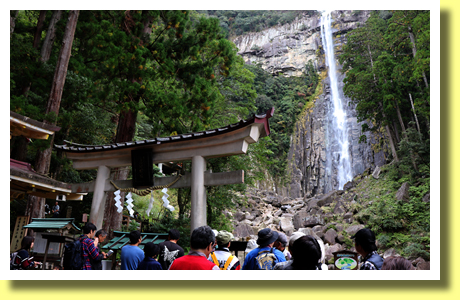
Kumano Nachi Taisha, one of Kumano Grand Shrines in Kumano Sanzan, is located in Nachi-Katsuura Town, Wakayama Prefecture. It is said that Nachi Taisha was founded originally to enshrine Nachi-no-taki ( Nachi Waterfall - above ) at the foot of the waterfall.
Nachi Taisha was moved to its present site in the 4th century, while Hiro-jinja, an associsted shrine, was founded at the foot of Nachi-no-taki, 133 meters high.
|
|
Seiganto-ji Temple
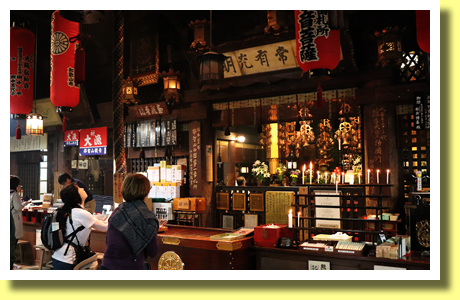
There is Seiganto-ji Temple ( above ) in the site of Nachi Taisha. Seiganto-ji Temple is included in UNESCO World Heritae Site "The Sacred Sites and Pilgrimage Routes in Kii Mountain Range" as well as three Kumano Taisha are.
It is said that the temple was founded in the 4th century by Ragyo Shonin, an Indian priest. Its main hall was reconstructed in A.D.1590 by Hideyoshi Toyotomi who built a large castle in Osaka before he unified Japan. Its main hall is one of designated National Important Cultural Properties of Japan.
|
|
Fudarakusan-ji Temple

Fudarakusan-ji Temple, located at the foot of Nachi Taisha is also included in UNESCO World Heritage Site "The Sacred Sites and Pilgrimage Routes in Kii Mountain Range". A boat ( above ) is exhibited in the site of the temple.
Some Buddhist believe that "Fudaraku" is the pure land which exists in the southern seas. Fudarakusan-ji is famous for those who had sailed for Fudaraku. The exhibited is a reconstruction of the boats which had sailed for Fudaraku. A few dozens had sailed through the 9th-18th centuries but no one returned except one who escaped out of the boat. He landed at an island nearby and was thrown into the sea by the people.
|
|
Nama Maguro ( ocean-fresh tuna )
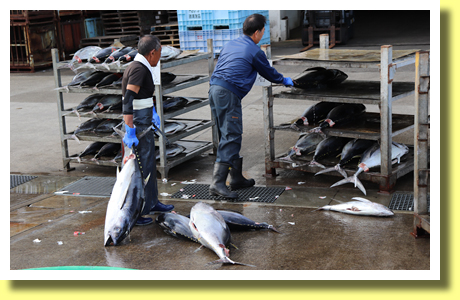
In Nachi-Katsuura where located are Nachi Taisha, Nachi-no-taki, Seiganto-ji and Fudarakusan-ji, there is a commercial fishing port which is famous for the largest catch of Nama Maguro ( ocean-fresh tuna - above ). So tourists, staying in the town, could enjoy eating various tuna dishes.
|
|
Otoro Sashimi ( fattiest tuna sashimi )
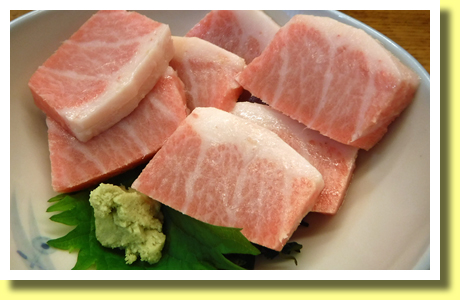
The above photo shows Otoro Sashimi ( fattiest tuna sashimi ). Exactly fattiest sashimi of ocean-fresh tuna, one of the most popular seafoods. No more explanation is required.
|
|
Shirako ( milt ) of tuna
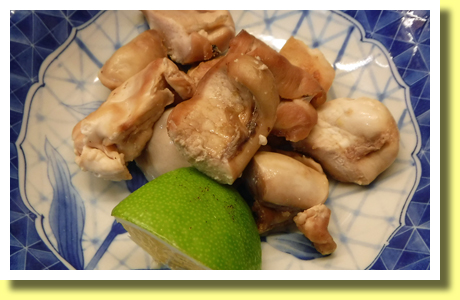
The above photo shows roasted Shirako ( milt ) of tuna. So nice with sake. I have not experienced the taste except in Nachi-Katsuura.
|
|
Sushi
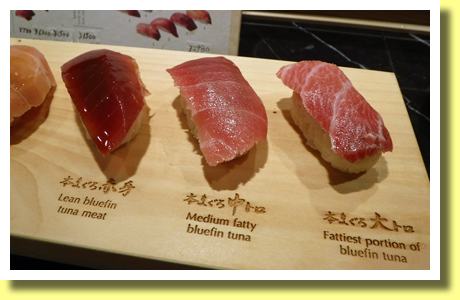
Needless to say, there in Nachi-Katsuura are sushi restautants serving various kinds of sushi topped with Maguro ( tuna ) such as above.
UNESCO may think about Maguro dishes in Nachi-Katsuura being included in the World Heritage Site.
|
Copyright (c) 2021 Achi-Kochi Zanmai Co., Ltd.
|